Understanding Feather Loss in Parrots: Causes and Solutions
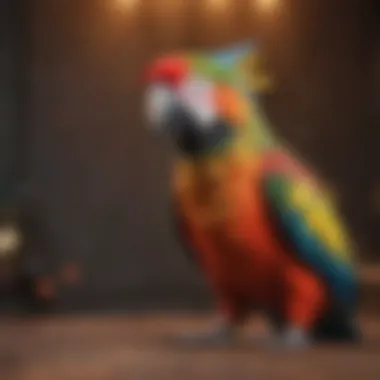
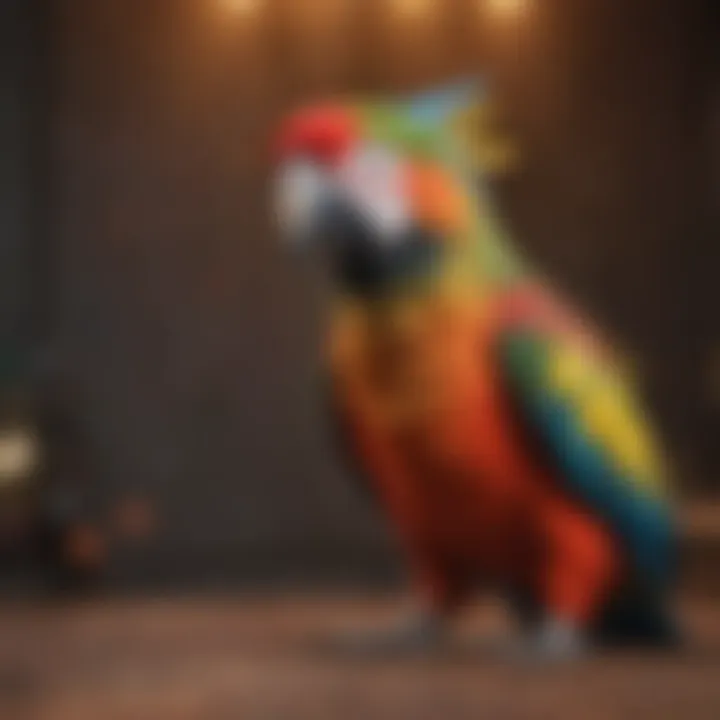
Intro
Feather loss in parrots can be distressing for both the birds and their owners. For many pet bird enthusiasts, understanding the reasons behind this phenomenon is vital for ensuring the well-being of their companions. When a parrot loses feathers, it can indicate underlying health concerns that need addressing. Additionally, the psychological effects of feather loss can be profound, impacting a bird's behavior and overall mental state. This guide aims to provide pet bird owners with crucial insights into feather loss, covering its causes, possible effects on health and behavior, and solutions to mitigate the issue.
Care Tips
Proper care routines for parrots are fundamental for promoting overall feather health. Here are some vital elements to consider.
Daily Care Routines
Daily interaction with your parrot is essential. Spend time talking to your bird, offering treats, and ensuring it receives mental stimulation. A consistent routine can reduce stress, which is important for preventing feather loss.
Cage Setup and Maintenance
The living environment of a parrot plays a significant role in its health. Ensure that the cage is spacious enough for flight and play. Place perches at varying heights and provide plenty of toys for engagement. Regularly check the cage for cleanliness to prevent respiratory issues.
Hygiene and Cleaning Practices
Hygiene is often overlooked but is critical in avoiding infections that may lead to feather loss. Clean food and water dishes daily, and ensure the cage is deep-cleaned weekly. This practice helps eliminate molds and bacteria, keeping your parrot healthy.
Seasonal Care Adjustments
Seasonal changes can impact a parrot's health and feather growth. During winter, use a humidifier to maintain moisture levels in the air. In contrast, ensure proper ventilation in summer to prevent overheating.
Behavioral Insights
Understanding a parrot's behavior is pivotal in addressing feather loss.
Understanding Bird Body Language
A parrot's body language can indicate its emotional state. Signs of stress, such as feather plucking or aggressive behavior, should be monitored carefully. Understanding these signals helps create a more supportive environment.
Common Behavioral Issues and Solutions
Behavioral issues often stem from environmental stress or boredom. Ensure enough interaction and stimulation to reduce the likelihood of these problems.
Positive Reinforcement Techniques
Utilizing positive reinforcement can encourage desirable behavior. Offering treats when your parrot interacts with toys or engages in social behavior can be very effective.
Social Interaction Needs
Parrots are highly social creatures and require regular interaction with their owners or other birds. Insufficient socialization can lead to depression and feather loss.
Nutrition Guides
Diet plays a critical role in feather health. A balanced nutrition plan helps support overall well-being.
Essential Diet Components
A well-rounded diet for parrots includes seeds, pellets, fruits, and vegetables. This mixture provides the necessary nutrients for feather growth.
Safe and Toxic Foods
Ensure that you know which foods are safe and which are harmful. Avocado, chocolate, and caffeine should be avoided as they are toxic to parrots.
Supplements and Treats
When needed, consider bird-safe supplements to enhance vitamin intake. Some parrots benefit from calcium and omega-3 supplements.
Feeding Strategies for Different Species
Not all parrots have the same dietary needs. Research the specific nutritional requirements of your parrot's species, as this can vary significantly.
Wellness and Health
Routine health assessments can prevent many issues related to feather loss.
Routine Health Checkups
Regular veterinary visits are essential for maintaining a parrot’s health. A knowledgeable avian vet can identify underlying problems that may lead to feather loss.
Identifying Symptoms of Illness
Look for signs of illness, such as changes in eating habits, lethargy, or excessive feather loss. Early detection is crucial for effective treatment.
Preventative Care and Vaccinations
Vaccinations can prevent common avian diseases. Consult with your vet to ensure your parrot is up to date.
Mental and Emotional Well-being
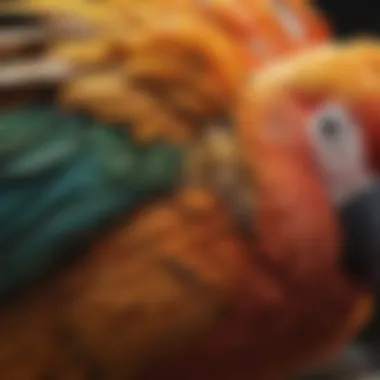

Mental health is as important as physical health. Engaging your parrot through interaction and training can improve its emotional state significantly.
Enriching Activities
Offer a variety of activities to stimulate your parrot both physically and mentally.
Toys and Playtime Ideas
Provide a selection of bird toys that cater to your parrot’s chewing and climbing needs. Rotate toys regularly to keep their interest.
Training and Tricks
Training sessions are excellent for bonding and mental stimulation. Simple tricks keep your parrot engaged and can help reduce anxiety.
Outdoor Activities and Interaction
If safe to do so, outdoor time can provide fresh air and new experiences. Always supervise your parrot when outside.
DIY Projects for Mental Stimulation
Consider creating DIY toys or puzzles that encourage problem-solving. These projects can promote mental health and prevent feather plucking.
Understanding the nuances of parrot care is essential. Thoughtful consideration of their environment, diet, and care routines can prevent feather loss and encourage a healthy, vibrant life.
Intro to Parrot Feather Loss
Feather loss in parrots is a vital topic that deserves attention. Understanding this condition operates at the intersection of avian physiology, psychology, and environmental factors. For parrot owners, knowing the causes and effects of feather loss can empower responsible care and prompt action when necessary. This knowledge does not merely enhance the bond between the owner and bird but also ensures maintaining the parrot’s overall well-being.
Among the many functions that feathers perform, they play an essential role in thermoregulation, flight, and protection. When a parrot starts losing feathers, it is not merely a cosmetic issue. The impact can extend into serious health concerns and behavioral changes that can pose real challenges for both the parrot and the owner. Addressing feather loss early can make a significant difference, allowing owners to implement effective prevention strategies and treatment options.
In this article, a comprehensive exploration of feather loss in parrots will unfold. Various aspects will be covered, including the significance of feathers, the anatomy involved, common causes of feather loss, its effects on health, and strategies for management and treatment. This structured approach aims to equip pet bird owners with essential insights, facilitating better decisions for their feathered companions.
Understanding the Importance of Feathers
Feathers are not just physical features of parrots; they are crucial for survival and essential for various functions. They provide warmth, aid in flight, and serve as essential apparatus in communication and social interactions among birds. When parrots display feather loss, several underlying factors may be evident—environmental stressors, nutritional deficits, or serious health concerns.
The feathers also home the intricate relationships that parrots have with their environment—both their natural habitat and their human caretakers. Feathered companions express their emotional states through their plumage. Healthy, vibrant feathers can indicate a happy and well-adjusted bird. Conversely, deterioration in feather quality or loss can reveal stress or illness, signaling that the parrot needs immediate attention.
Taking the time to understand the importance of feathers can motivate parrot owners to observe their birds closely and respond to any signs of distress or health issues promptly.
The Anatomy of Parrot Feathers
The structure of parrot feathers is complex and fascinating. Each feather serves specific roles, contributing to the bird's overall functionality. A feather is made up of a central shaft called the rachis, from which barbs extend outward. These barbs interlock to form the smooth surface that aids in flight and insulation.
There are various types of feathers, including:
- Contour Feathers: These cover the body and give the parrot its shape.
- Flight Feathers: Located on the wings and tail, these are essential for flying.
- Down Feathers: These provide insulation and warmth.
The health of feathers is directly related to the bird's overall wellness. Any abnormalities or loss can indicate nutritional deficiencies, stress, or health problems. A thorough understanding of feather anatomy can help owners recognize when their parrot may be facing challenges.
"Healthy feathers are a direct reflection of a parrot’s physical and emotional state."
By grasping the intricate relationship between feather structure and the parrot's health, owners can make informed decisions regarding care, diet, and environmental factors that contribute to a bird's quality of life.
Common Causes of Feather Loss
Feather loss in parrots can arise from a number of factors. Understanding these causes is vital for pet bird owners seeking to maintain their birds' health and well-being. By identifying the root causes, owners can implement effective strategies to mitigate the loss or prevent it altogether. Each potential cause carries its own implications, requiring careful consideration when assessing a parrot's condition and behavior. Recognizing these elements is essential in fostering a supportive environment conducive to feather growth.
Environmental Stressors
Environmental factors play a significant role in feather loss. Variations in temperature, humidity, and exposure to drafts can cause stress in parrots. They are sensitive creatures, and sudden changes in their environment may lead to anxiety and subsequent plucking. Loud noises, such as those from household appliances or nearby traffic, can also contribute to feather loss. A stable living environment reduces stress and ensures that parrots feel secure, which is important for their overall health.
Nutritional Deficiencies
Nutrition is another critical aspect that affects feather health. A balanced diet containing essential vitamins and minerals is key for parrots. Deficiencies in vitamins A, E, and certain fatty acids can lead to poor feather quality, resulting in increased shedding. It is necessary for owners to provide a diverse diet that includes fresh fruits, vegetables, and high-quality pellets. Proper dietary management supports feather health and helps in preventing loss.
Health Issues
Health issues among parrots can manifest in feather loss. Various medical conditions contribute significantly to this problem, including:
Skin Diseases
Skin diseases in parrots lead to irritation and itching. This discomfort often causes birds to pluck their feathers as a means of relief. Common skin conditions include bacterial and fungal infections, which usually necessitate veterinary intervention. Recognizing skin diseases early is important, as timely treatment can reverse damage and restore feather integrity.
Parasites
Parasites, both external and internal, can severely impact a parrot’s well-being. Mites and lice, for instance, cause itching and discomfort, prompting birds to engage in inappropriate feather plucking. Regular health checks can help detect and treat parasite infestations before they escalate. Understanding the impact of parasites enables owners to maintain their birds' health effectively.
Respiratory Issues
Respiratory problems can also contribute to feather loss. Conditions such as bronchitis or pneumonia limit a bird's ability to breathe comfortably. Respiratory distress may lead to disruptions in typical behaviors, including preening, which is vital for feather care. Monitoring for signs of respiratory issues allows owners to seek prompt treatment, ultimately preventing feather loss associated with underlying health problems.
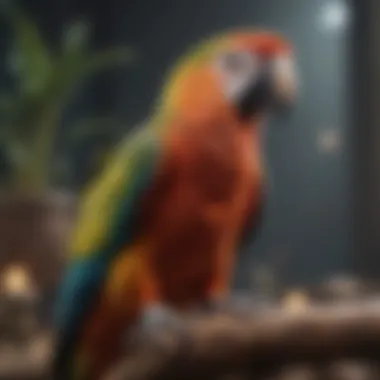

Behavioral Causes
Behavioral factors are often the focus when addressing feather loss. The mental state of a parrot directly influences its propensity to pluck.
Stress and Anxiety
Stress and anxiety are common contributors. Birds may become anxious due to changes in their routine, new environments, or the presence of other pets. Parrots often pluck feathers as an outlet for their stress. By creating a peaceful and predictable environment, owners can significantly reduce the likelihood of anxiety-induced feather loss.
Boredom and Lack of Stimulation
A parrot's intellectual needs must be met to prevent boredom. Insufficient stimulation leads to negative behaviors, including feather plucking. Interactive toys, puzzles, and social interaction provide essential mental engagement. Owners should incorporate various activities into their bird's routine to keep them enriched and prevent feather loss associated with boredom.
Impact of Feather Loss on Parrots
Feather loss in parrots is a significant concern for bird owners, as it relates closely to the overall well-being and health of these unique creatures. Understanding the impacts of feather loss is crucial, as it not only affects the physical appearance of parrots but also their emotional and psychological states. Feathers serve multiple functions, such as insulation, protection, and aiding in flight. When parrots experience feather loss, these functions become compromised, leading to various health complications.
Physical Health Effects
The physical health effects of feather loss can be profound. When a parrot loses feathers, it may not be able to regulate its body temperature effectively. This can lead to hypothermia or other temperature-related issues, particularly if the bird is exposed to cold environments. Furthermore, exposed skin can become vulnerable to infections, as it lacks the protective barrier that feathers provide. Parrots may also exhibit behaviors such as excessive preening or biting, causing further damage to their skin and leading to complications like dermatitis.
In addition to the risk of infections, weight loss can become an issue if the bird becomes less active. A parrot that cannot fly or move easily may become sedentary, leading to obesity and other metabolic problems over time. Moreover, if feather loss is linked to nutritional deficiencies, it becomes crucial to address dietary imbalances promptly. Without proper nutrients, birds may not only suffer feather loss but also face broader health challenges, which can affect their lifespan and quality of life.
Psychological Effects
Feather loss can also have significant psychological effects on parrots. Birds are sensitive creatures, and a sudden change in their appearance can influence their self-esteem and confidence. A parrot that feels unattractive or out of place due to feather loss may become withdrawn or exhibit signs of depression. Behavioral changes can manifest in various ways, such as increased irritability or reduced social interaction with owners and other birds.
Moreover, the mental strain caused by feather loss can lead to more severe behavioral issues, including ongoing self-mutilation and chronic plucking. To mitigate these effects, it is essential for bird owners to be vigilant and provide a nurturing environment. Creating a stable home and incorporating enriching activities can help support a parrot's mental health, easing the anxiety associated with feather loss.
"Feather loss is not only about feathers disappearing; it's about the bird's entire well-being. Understanding the implications can lead to better care and a stronger bond between the owner and their pet."
Overall, the impacts of feather loss extend beyond mere aesthetics. They affect the physical health and emotional states of parrots significantly. Holistic approaches in assessing the causes and responding accordingly will foster an environment where parrots can thrive, ensuring a healthier, happier, and more vibrant life for these cherished pets.
Diagnosis and Identification of Plucking
Diagnosing feather loss, specifically feather plucking, is crucial for any bird owner who wants to maintain the well-being of their parrot. Identifying the signs of plucking can lead to earlier intervention and treatment, which might prevent further feather loss and associated problems. Understanding the symptoms and getting a correct diagnosis from a veterinarian can help pinpoint the underlying causes. This comprehensive approach can lead to better management of the bird's needs, creating a healthier environment that encourages feather growth and well-being.
Recognizing Symptoms of Feather Plucking
Recognizing the symptoms of feather plucking in parrots is the first step for pet owners to take. Common signs include:
- Visible Feather Loss: Noticeable bare patches on the skin are the most direct indicator of plucking. The feathers may appear uneven or entirely missing in several areas.
- Blood on Feathers or Skin: Sometimes, plucking can lead to bleeding. Observing blood marks is alarming and requires immediate attention.
- Behavior Changes: An increase in nervous behavior or signs of distress may accompany feather loss. The bird may engage in excessive grooming or show aggression.
- Increased Vocalization: Changes in vocal patterns may reflect discomfort or anxiety in the bird.
Early recognition of these symptoms is essential. It allows owners to monitor their birds and seek help from avian specialists before the situation escalates.
Veterinary Diagnosis
Veterinary diagnosis plays a critical role in understanding feather loss. After observing symptoms, it is important to consult an avian veterinarian. The vet may conduct a series of examinations to determine the root causes of plucking. Some procedures may include:
- Physical Examination: A thorough physical check can reveal skin conditions, infections, or parasites that could contribute to feather loss.
- Skin Scraping: This is a common diagnostic tool used to reveal any underlying skin infections or diseases.
- Blood Tests: Blood work may be necessary to detect nutritional deficiencies or other systemic issues affecting the bird's overall health.
- Behavior Assessment: The vet might evaluate the parrot's behavior patterns to identify stress factors that might lead to feather plucking.
A comprehensive veterinary assessment ensures appropriate treatment. By identifying both the physical and behavioral factors contributing to feather loss, effective solutions can be implemented.
Overall, a proactive approach to diagnosing feather plucking can vastly improve the quality of life for parrots, leading to healthier feather growth and a more balanced emotional state.
Prevention Strategies
Prevention strategies for feather loss in parrots are essential. By addressing the underlying causes before they escalate, bird owners can foster healthier environments for their feathered companions. The significance of prevention lies in its ability to mitigate stressors that lead to feather loss. It can also promote a more balanced lifestyle for parrots, reducing the risks related to health and behavior that often accompany this issue.
Creating a Stable Environment
A stable environment is vital for parrots. These birds thrive in spaces that are consistent and predictable. Sudden changes in their surroundings can create anxiety, contributing to feather plucking. To ensure stability:
- Placement of the Cage: Consider where you place the cage. It should be in a quiet but social area of the house, where they can observe daily activities without being overwhelmed.
- Routine: Establish a feeding and playtime routine. Parrots are intelligent and benefit from knowing what to expect each day. Consistency helps reduce stress.
- Minimize Noise and Disturbances: Loud noises, like vacuuming or loud music, can startle parrots. Keeping their environment calm is crucial, especially during sensitive times like molting.
By implementing these strategies, owners can help create an atmosphere that supports natural behaviors and overall well-being.
Diet and Nutrition Management
Nutritional management is another key aspect of prevention. A poorly balanced diet can lead to deficiencies that affect feathers' health. Parrots require a mix of seeds, fruits, vegetables, and fortified pelleted foods. To ensure optimal nutrition:
- Variety: Offer various food types. This not only provides essential nutrients but also keeps meals exciting for the bird.
- Fresh Produce: Include fresh vegetables and fruits daily. Leafy greens, carrots, and bell peppers are excellent choices.
- Supplements: Consult an avian vet about potential supplements, especially if there are signs of deficiencies like dull feathers or lethargy.
By focusing on a well-rounded diet, owners can significantly reduce the likelihood of feather loss related to nutritional issues.
Enrichment Activities for Parrots
Enrichment activities play an important role in addressing behavioral causes of feather loss. Parrots are intelligent and curious creatures. When they lack mental stimulation, they may resort to destructive behaviors, including feather plucking. To enhance their environment:
- Toys: Rotate their toys regularly. This maintains interest and encourages play. Materials like wood, cardboard, and leather can promote healthy beak and feather use.
- Out of Cage Time: Allow supervised out-of-cage time. This encourages exploration and interaction, fulfilling their natural instincts.
- Training: Engage in positive reinforcement training. Teaching tricks or commands can mentally stimulate parrots while strengthening the bond between bird and owner.
Incorporating these enrichment activities helps keep parrots engaged. A stimulated parrot is less likely to experience boredom-related feather loss.
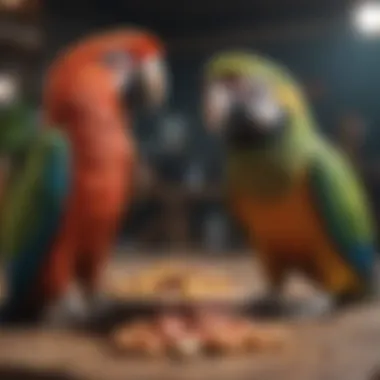
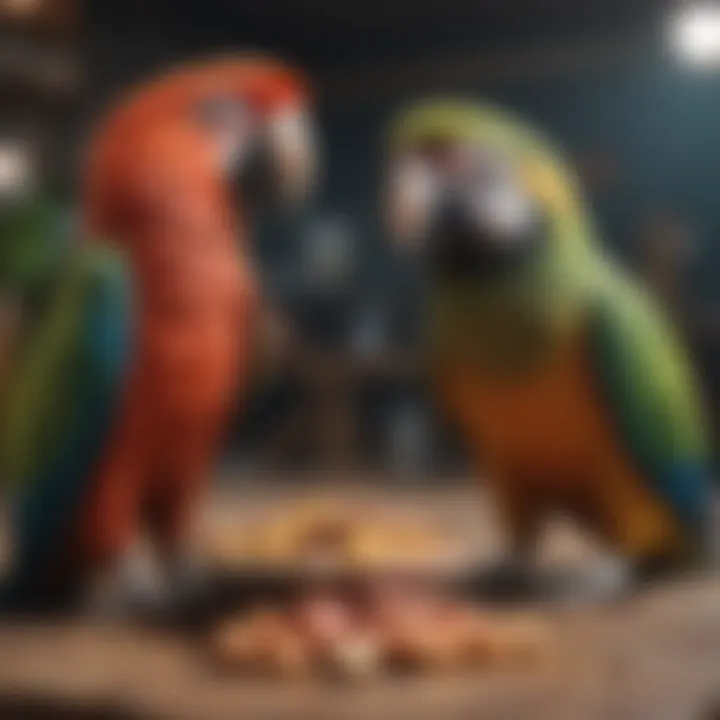
Treatment Options for Plucked Feathers
Feather plucking in parrots represents a complex issue that often requires multifaceted treatment approaches. Understanding how to effectively address feather loss is crucial for both the physical recovery of the parrot and the emotional health of the bird owner. The treatment options available can significantly benefit the parrot, enhancing its quality of life while encouraging a return to natural feather growth. In many cases, a combination of different strategies may be necessary to achieve optimal results.
Behavior Modification Techniques
Behavior modification techniques focus on altering the parrot's actions and reactions that lead to feather plucking. These strategies consider the underlying causes of plucking, often linked to stress, boredom, or attention-seeking behaviors.
- Positive Reinforcement: Rewarding desirable behaviors can help pets feel more secure. Treats or favorite toys can divert their attention from plucking.
- Routine Establishment: Keeping a consistent schedule for feeding, play, and rest can provide a sense of security. Parrots thrive on routine, which can reduce anxiety and stress.
- Environmental Enrichment: Provide a variety of toys, climbing structures, and interaction opportunities. This helps prevent boredom, which is a common trigger for feather plucking.
- Social Interaction: Parrots are social creatures. Ensuring they receive enough socialization from humans or other birds can alleviate loneliness and help reduce stress-related behaviors.
Adopting these techniques may require patience and consistency. Such behavior modification strategies can remove the incentive for plucking, allowing feathers to grow back normally over time.
Medical Treatments
In some cases, feather plucking may be symptomatic of underlying health issues that necessitate medical intervention. Identifying and addressing these conditions is key to promoting the parrot’s recovery and achieving long-term solutions to feather loss.
- Veterinary Assessment: A visit to an avian veterinarian is essential. The vet can perform tests to rule out diseases, parasites, or allergies that could be contributing to the feather loss.
- Medications: Depending on the diagnosis, your veterinarian might prescribe medications such as anti-anxiety drugs. These can help manage stress levels if behavior modification techniques alone are not sufficient.
- Nutritional Supplements: Addressing any nutritional deficiencies is vital. A well-balanced diet that includes vitamins and minerals can support feather regrowth. Supplements may be recommended based on the vet’s assessment.
- Skin Treatments: If the plucking is due to skin irritations or allergies, topical or systemic treatments may be deemed necessary to alleviate the symptoms and promote healing.
Combining medical treatment with behavioral strategies offers a comprehensive approach to solving feather loss issues. These treatments not only alleviate the immediate problems but also protect the parrot's overall well-being.
Ultimately, a thorough understanding of both behavior modification and medical options empowers bird owners. With the right approach, it is possible to reduce feather plucking, facilitating a happier and healthier life for parrots.
The Role of Avian Specialists
Feather loss in parrots can be complex, necessitating a multi-faceted approach to treatment and care. Avian specialists play a crucial role in diagnosing and managing these issues. They are professionals who focus on bird health and behavior, offering insights that are not typically available through general veterinarians. Their expertise encompasses various elements, including medical treatment, behavioral analysis, and nutritional guidance. This section is designed to enlighten the reader on when to seek a specialist’s advice and how they can aid in the well-being of parrots facing feather loss.
When to Consult an Avian Vet
There are specific instances when it is essential to consult an avian vet. These include:
- Severe Feather Loss: If a parrot shows noticeable patches of missing feathers, it’s time for a professional evaluation.
- Behavior Changes: Changes in behavior, such as increased aggression or withdrawal, may signal underlying health issues.
- Physical Symptoms: Signs like skin lesions, excessive scratching, or changes in appetite require veterinary attention.
- Persistent Plucking: If a parrot continues to pluck its feathers despite owner interventions, professional help is necessary.
- Dietary Concerns: Issues with diet or nutrition should also prompt a visit. An avian vet can help assess nutritional needs specific to the species.
"Consulting an avian vet ensures that underlying health problems can be identified and treated promptly, increasing the chances of recovery."
Regular check-ups with an avian specialist can aid in early detection of issues that may lead to feather loss. An initial consultation can provide a thorough health assessment and create a baseline for future evaluations. Proactive care can save the bird from distress and potential long-term damage.
Working with Behaviorists
Behaviorists bring additional insights into how environmental and psychological factors contribute to feather loss. Engaging with a behaviorist can help identify triggers within a parrot's surroundings or routine that lead to stress or boredom. Their expertise is particularly beneficial when it comes to behavioral issues such as feather plucking. Important points when working with behaviorists include:
- Tailored Solutions: Behaviorists can create customized programs that address specific needs of an individual parrot.
- Stimulation Techniques: They provide strategies for enrichment, ensuring that parrots have enough mental and physical stimulation.
- Stress Management: Training on how to manage stressors in the environment can prevent further feather loss.
- Ongoing Support: Behaviorists often offer follow-up consultations to monitor progress and adapt approaches as needed.
By collaborating with both avian vets and behaviorists, parrot owners can adopt a comprehensive strategy in the fight against feather loss. This dual approach can enhance the understanding of health and behavioral aspects, thus promoting a more fulfilling life for the parrot.
Best Practices for Bird Owners
Best practices for bird owners encompass a wide array of considerations that can drastically affect the overall well-being of parrots. Feather loss is a complex issue that can arise from various factors, including environmental conditions, diet, and behavioral elements. By adhering to best practices, owners can create an environment that mitigates these risks and promotes feather health. Awareness and education are imperative, as small changes can lead to significant improvements for their feathered companions.
Monitoring Feather Health
Monitoring feather health is an essential aspect of parrot care. This involves regular evaluations of the bird's plumage to detect any early signs of issues. Owners should be keen observers, looking for changes in feather condition and patterns. A healthy parrot typically displays vibrant and intact feathers without excessive shedding or bald patches.
To effectively monitor feather health, consider the following steps:
- Daily Observations: Spend time watching your parrot daily. Notice any changes or abnormalities in its feathers.
- Regular Grooming: Regular grooming aids in maintaining feather health. Use bird-safe brushes to remove loose feathers and debris from the plumage.
- Seek Veterinary Input: If you observe excessive feather loss or uneven feather growth, consult an avian vet promptly. They can provide specific tests to determine any underlying medical conditions.
Monitoring not only evaluates physical health but also gives insight into a bird's emotional state. Behavioral changes often correlate with feather issues, providing a broader context to a parrot's overall health.
Promoting Overall Well-being
Promoting overall well-being involves a holistic approach to parrot care that enhances both physical and mental health. Tailoring the environment and routine to meet the needs of the parrot can play a crucial role in reducing feather loss. Some key strategies include:
- Balanced Diet: Providing a nutritious diet is the foundational step towards ensuring optimal health. It should include a variety of fruits, vegetables, seeds, and specialized pellets designed for parrots.
- Social Interaction: Parrots are social creatures and thrive on interaction. Spend quality time with them to enhance their emotional health. This could involve talking, playing, or simply being present, fostering a strong bond.
- Environmental Enrichment: Offer different activities and toys to prevent boredom. Rotate toys frequently to keep the parrot engaged. Simple puzzles and foraging activities can stimulate mental functions.
- Suitable Cage Environment: The cage should allow free movement and mimic natural habitats as much as possible. Ensure proper sizes and layouts so that the parrot does not feel confined or anxious.
Important Note: A well-rounded approach that combines diet, socialization, and enrichment ultimately contributes to a healthy feather growth.
Ending
Feather loss in parrots is a significant issue that can greatly affect their overall well-being. This article has explored various facets of feather loss, including its causes, impacts, and solutions. Understanding these elements is critical for anyone caring for parrots. The importance of keeping your feathered companions healthy cannot be overstated. A parrot's feathers are not just aesthetic; they play vital roles in insulation, flight, and protection from the elements.
Effective management and care depend on recognizing the signs of feather loss early. By understanding the environmental factors, nutritional needs, and potential health issues, bird owners can create an environment conducive to healthy feather growth. Moreover, recognizing behavioral causes such as stress and boredom can lead to important interventions, allowing us to enrich the lives of these intelligent creatures.
The solutions discussed in this article, from seeking veterinary advice to engaging avian specialists, are essential steps in ensuring that our parrots maintain their health and happiness. Addressing feather loss is not merely about aesthetics; it's about fostering a deeper bond with our pets while promoting their well-being. By implementing prevention strategies and treatment options discussed here, bird owners can significantly enhance the quality of life for their parrots.
Summary of Key Points
- Importance of Understanding Feather Loss: Recognizing the significance of feathers and their impact on a parrot's health is crucial.
- Identifying Causes: Environmental stressors, nutritional deficiencies, health issues, and behavioral problems all contribute to feather loss.
- Impact on Health: Feather loss can lead to both physical and psychological challenges for parrots, including stress and impaired insulation.
- Diagnosis and Treatment: Accurate identification of the cause is key to developing effective treatment strategies, whether through dietary adjustments or behavioral modification.
- Consistent Monitoring: Bird owners should regularly check their parrot's feathers to catch any changes early and seek appropriate help when necessary.
Final Thoughts on Feather Care
Caring for a parrot requires commitment, knowledge, and attention to detail. This article has highlighted the delicate balance of factors that can lead to feather loss and the necessary steps to alleviate these issues. As pet bird owners, it is our responsibility to create a supportive and stimulating environment to encourage natural feather growth.
Nourishment plays a vital role, so adequate attention should be given to providing a balanced diet rich in essential vitamins and minerals. The mental stimulation and physical activity cannot be overlooked either; both are integral for a parrot's happiness and feather health.
In summary, feather care is an ongoing journey. Understanding the nuances of the causes and impacts of feather loss empowers bird owners to make informed decisions. This knowledge fosters a healthy environment for parrots, ensuring they remain vibrant and engaging companions for many years to come.
"A happy parrot is a feathered one. Monitoring and caring for their feathers is a part of that happiness."
For more information on avian care, refer to resources like Wikipedia, Britannica, and community advice on platforms like Reddit and Facebook.















